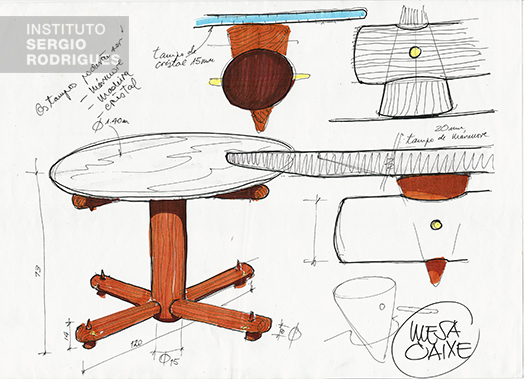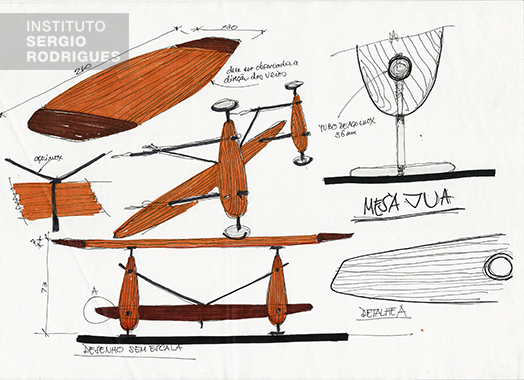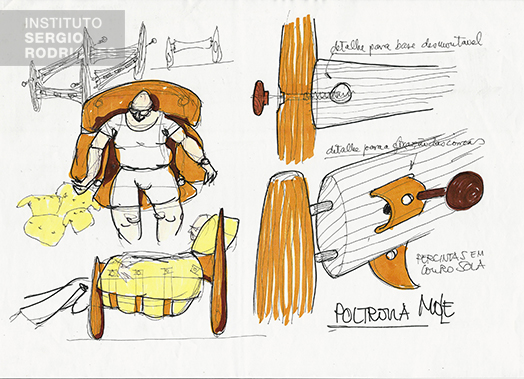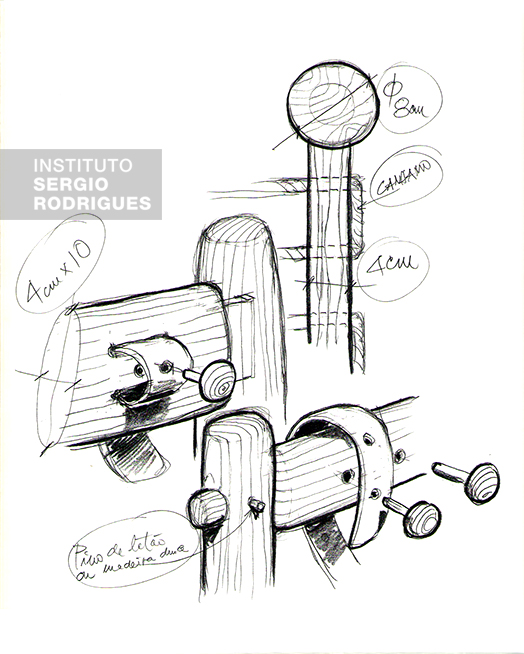"The spirit of the forest remains when the wood is treated with love." (Sergio Rodrigues)
“The spirit of the forest remains when the wood is treated with love.” (Sergio Rodrigues)
When he started designing furniture, Sergio went out in a frantic search for a design that could represent the spirit “of our people.” To achieve it, he plunged into a little explored area in which “wood, our raw material, leather, straw, and thick fabrics would have primordial projection,” as he used to say. “They did not know this, but by designing with these materials, they were delivering a mortal blow to thin-feet furniture, and using Jacaranda was the blow of death on the pau-marfim style,” said Sergio, once, during an interview with Casa e Jardim magazine.
Sergio then went in pursuit of new projects and materials. Aided by what he called “the great contribution of technology,” which brought new equipment and machinery, and by the “appearance of an infinite range of materials,” Sergio left to sow the seeds of his work at Oca and, later, at Meia-Pataca. Naturally, his passion for wood began when he was still very young and he saw his uncle James’ workers use wood to fill his uncle’s orders.
As once said the architect and urban planner Lucio Costa, Sergio was able to “superimpose on modern furniture production elements seen at the Brazilian homes of our ancestors.” Sergio’s use of wood and straw in his work reinforces that view. He worked with these two materials very well, creating new forms of seats that have become classics, such as the Oscar armchair, in honor of Oscar Niemeyer, of 1956: Solid wood, originally Jacaranda, with a backrest and straw seat. To honor Lucio Costa, Sergio designed the Lucio Chair, also made of wood with seat in straw.
At first and for a long time, Sergio chose Jacaranda, a type of hardwood that is durable and easy to work with, as his favorite. However, the widespread use of this type of wood and its smuggling abroad led to its depletion, and, from the 1980s, he went on to use wood such as imbuia, pau-marfim, and frejó, among others. Later, he also used eucalyptus and tauari. Straw and leather – materials whose tradition dates back to colonial furniture in Brazil – play an important supporting role in his creations, and only in a few pieces did its use surpass the use of timber.
“Furniture considered as formal was made of Jacaranda because the wood itself added dignity to the product. But for less expensive pieces, made on a larger scale, the pieces were made of wood that had a touch of Jacaranda or were also masked of Jacaranda, in other words, varnished like it, to give it that special quality. I started using Jacaranda precisely because it had that quality, with that in mind. The furniture that used to be made in palaces and in more formal settings here in Brazil were of Jacaranda. Then I started using this material to enhance design too.”
A while after having used Jacaranda in his creations, Sergio said he felt guilty for having used this type of hardwood so broadly: “Jacaranda was a type of wood that was easily found at first. Then it started getting increasingly difficult to use it. I feel like I am one of the killers, one of the major consumers of Jacaranda.” His daughter Veronica said that he, in fact, immortalized Jacaranda. Despite his mea culpa, Sergio had a conviction with regard to the material he used in his work. He once said: “The spirit of the forest remains when the wood is treated with love.”
In the interview he gave to Afonso Luz, Sergio discussed the use of the wood: “Our material, our key raw material is wood. I used to think that we should continue using wood until we had adequately or perfectly studied or developed other elements or other materials that could come to be applied, such as metal. Some people say I do not like metal. I like metal. I think it’s wonderful. Bauhaus is made almost entirely of metal. The appearance of metallic structures in furniture was certainly a great addition. This side of the Bauhaus technology, which it added to its design, came as an opportunity to us. When they made Bauhaus, they wanted to use a material that was at hand. The industry in Germany was already providing a lot of evidence to that effect. In fact, Bauhaus furniture was only compositions. Of course, they were applied with a lot of “Bossa,” and a lot of design, and they were elements assembled without major frills, no need to sculpt the material. Here, at the time, wood was used not only in the assembly, but also worked like a sculpture, with all those grooves. But I believed it could also be used structurally, as raw material to compose these products. When I made Mole, they said: ‘Sergio, with this piece of yours, making this leather cushion with four legs, you defined the place perfectly, first observing a tradition of culture, which would be, in that case, the indigenous culture.’ As if the natives had created or had a Mole armchair. They treated wood with no refinement, or better, without worrying about making grooves or carving wood. There did not carve wood. They used wood as it is, as it comes from nature.”
Sergio used metal associated with timber at various moments. For example, he made the Leve Beto armchair for the Presidential Palace Waiting Hall structured in stainless steel, with a seat and back in polyurethane foam covered in velvet or leather and with hardwood arms.
To Sergio, the question was how to treat the wood, which could be a technological resource, and not just a material one. “It is logical that wood would be the material. You would have the traditional European way and the simple influences of people without the culture of special wood treatment, but with a structural view.”
From the moment Sergio realized that mass production of his furniture led to the need to find another solution on account of how hard it was to come across Jacaranda, even back then, he switched to other types of wood. “Since we had other woods available to us, it was easier to study them and adjust other woods with similar features. They may not be as beautiful as Jacaranda, but similar.” Since Jacaranda does not have a very broad variety of tones, Sergio began using other types of wood with lighter and darker shades, making some changes.
“Many pieces that used Jacaranda lacked the design qualities of the culture of the time. Not every piece of furniture made with Jacaranda is Brazilian design. Jacaranda was one of the important materials of that time. But not all of our horizons were aimed at it. So we moved on to other woods that have a certain color, a certain detail similar to or near Jacaranda. Ironwood, imbuia itself, had qualities that could be less expensive than Jacaranda but similar to that of this wood.” To Sergio, this new reality furniture facilitated manufacturing because the industry started using these materials for mass production. And Jacaranda was being gradually replaced.

Sketch of the "Caixe" Table that Sergio Rodrigues created in 1988, made out of solid hardwood and with a 20-mm round crystal top.

Sketch of the "Juá" table Sergio Rodrigues created in 2004, made out of solid hardwood with an oval top.

Sketch with details of the "Mole" Armchair Sergio Rodrigues created in 1957 in honor of his friend Otto Stupakoff.

Sketch showing details of the "Mole" Armchair, 1957.
